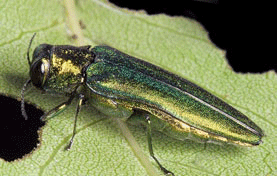The march continues.
Emerald Ash Borer, a beetle that kills all varieties of ash trees, has been positively identified from a tree in Mount Pleasant, in Henry County.
The latest discovery, announced Friday, July 11, 2014, brings to 10 the number of counties where the devastating beetle has been found in Iowa.
Previous reports about Emerald Ash Borer can be found below, and read on for more from the state’s Emerald Ash Borer team:
DES MOINES – A larva was collected by the Iowa EAB Team from a tree in Mt. Pleasant has been positively identified as the Emerald Ash Borer (EAB) by a federal identifier.
A statewide quarantine restricting the movement of hardwood firewood, ash logs, wood chips and ash tree nursery stock out of Iowa into non-quarantined areas of other states was issued on Feb. 4, 2014 and remains in place.
“EAB typically has a one-year lifecycle but in colder climates, it can take as long as two-years,” said State Entomologist Robin Pruisner of the Iowa Department of Agriculture and Land Stewardship. “Finding an EAB larva in July proof that there is no ‘safe time’ for moving firewood in Iowa. No matter the time of year, the risk of EAB being transported in firewood is very real.”
The Iowa EAB Team provides EAB diagnostic assistance to landowners and includes officials from Iowa Department of Agriculture and Land Stewardship (IDALS), Iowa State University Extension and Outreach, the Iowa Department of Natural Resources (DNR), USDA Animal Plant Health Inspection Service and the USDA Forest Service.
The Iowa EAB Team strongly cautions Iowans not to transport firewood across county or state lines, since the movement of firewood throughout Iowa or to other states increases the risk of spreading EAB infestations. Most EAB infestations in the United States have been started by people unknowingly transporting infested firewood, nursery plants or sawmill logs. Besides being transported by vehicle, the adult beetle can also fly short distances of approximately two to five miles.
Please contact Iowa EAB Team members to have suspicious looking trees checked. The State of Iowa will continue to track the movement of EAB on a county-by-county basis. Before a county can be officially recognized as infested, proof of a reproducing population is needed and an EAB must be collected and verified by USDA entomologists.


I’ve been following your coverage of EAB for a while, and appreciate your work. I wonder if you encountered any evidence or anecdotal information that the increase in EAB sightings has to do with heightened awareness of the pest? That is, more are being reported because more people are watching for them.
Thanks again, Paul
Thanks for your comment, Paul.
The last time I asked, I was told that the increase in reports is a combination of both vigilance and the pest spreading. It takes 3-5 years for Emerald Ash Borer to kill a tree, so it might not immediately be detected, even though it has been present. Have you seen any signs on ash trees in your area?